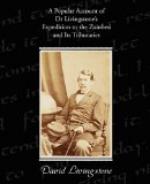On emerging we pitched our camp by a small stream, the Pendele, a few miles below the gorge. The Palabi mountain stands on the western side of the lower end of the Kariba strait; the range to which it belongs crosses the river, and runs to the south-east. Chikumbula, a hospitable old headman, under Nchomokela, the paramount chief of a large district, whom we did not see, brought us next morning a great basket of meal, and four fowls, with some beer, and a cake of salt, “to make it taste good.” Chikumbula said that the elephants plagued them, by eating up the cotton-plants; but his people seem to be well off.
A few days before we came, they caught three buffaloes in pitfalls in one night, and, unable to eat them all, left one to rot. During the night the wind changed and blew from the dead buffalo to our sleeping-place; and a hungry lion, not at all dainty in his food, stirred up the putrid mass, and growled and gloated over his feast, to the disturbance of our slumbers. Game of all kinds is in most extraordinary abundance, especially from this point to below the Kafue, and so it is on Moselekatso’s side, where there are no inhabitants. The drought drives all the game to the river to drink. An hour’s walk on the right bank, morning or evening, reveals a country swarming with wild animals: vast herds of pallahs, many waterbucks, koodoos, buffaloes, wild pigs, elands, zebras, and monkeys appear; francolins, guinea-fowls, and myriads of turtledoves attract the eye in the covers, with the fresh spoor of elephants and rhinoceroses, which had been at the river during the night. Every few miles we came upon a school of hippopotami, asleep on some shallow sandbank; their bodies, nearly all out of the water, appeared like masses of black rock in the river. When these animals are hunted much, they become proportionably wary, but here no hunter ever troubles them, and they repose in security, always however taking the precaution of sleeping just above the deep channel, into which they can plunge when alarmed. When a shot is fired into a sleeping herd, all start up on their feet, and stare with peculiar stolid looks of hippopotamic surprise, and wait for another shot before dashing into deep water. A few miles below Chikumbula’s we saw a white hippopotamus in a herd. Our men had never seen one like it before. It was of a pinkish white, exactly like the colour of the Albino. It seemed to be the father of a number of others, for there were many marked with large light patches. The so-called white elephant is just such a pinkish Albino as this hippopotamus. A few miles above Kariba we observed that, in two small hamlets, many of the inhabitants had a similar affection of the skin. The same influence appeared to have affected man and beast. A dark coloured hippopotamus stood alone, as if expelled from the herd, and bit the water, shaking his head from side to side in a most frantic manner. When the female has twins, she is said to kill one of them.




